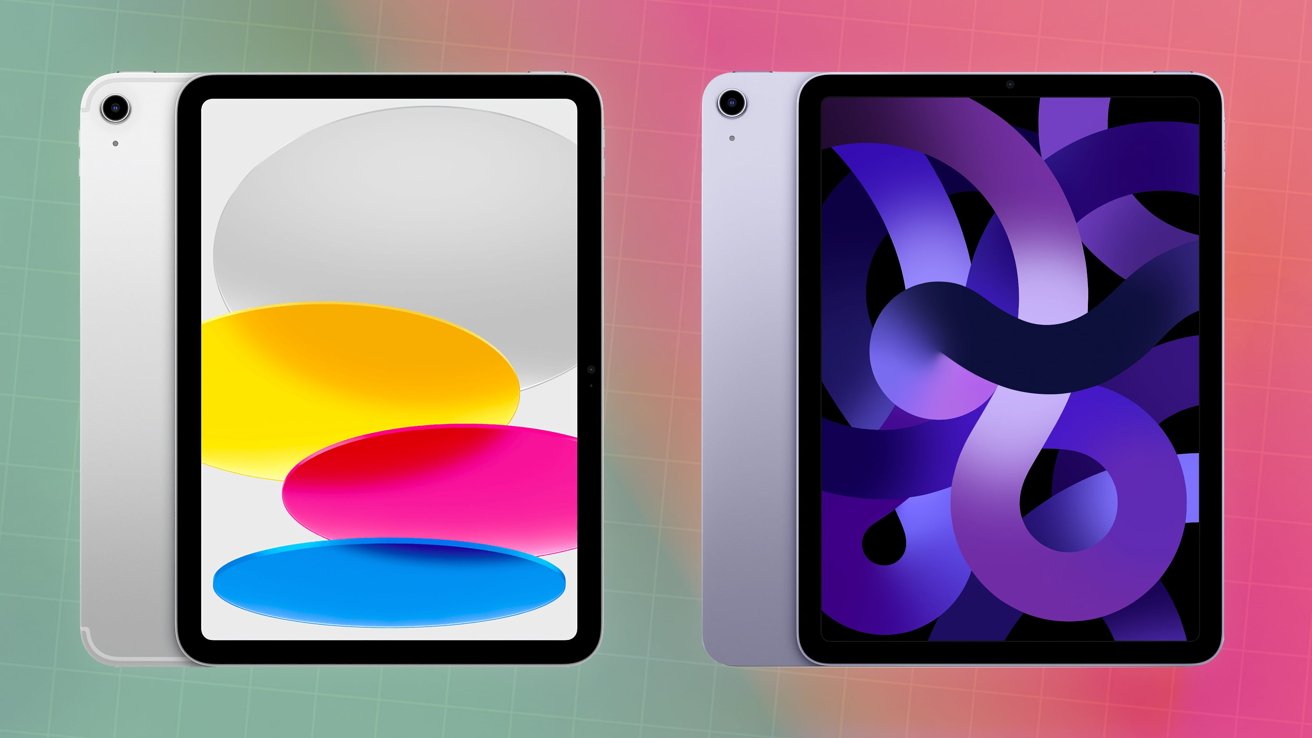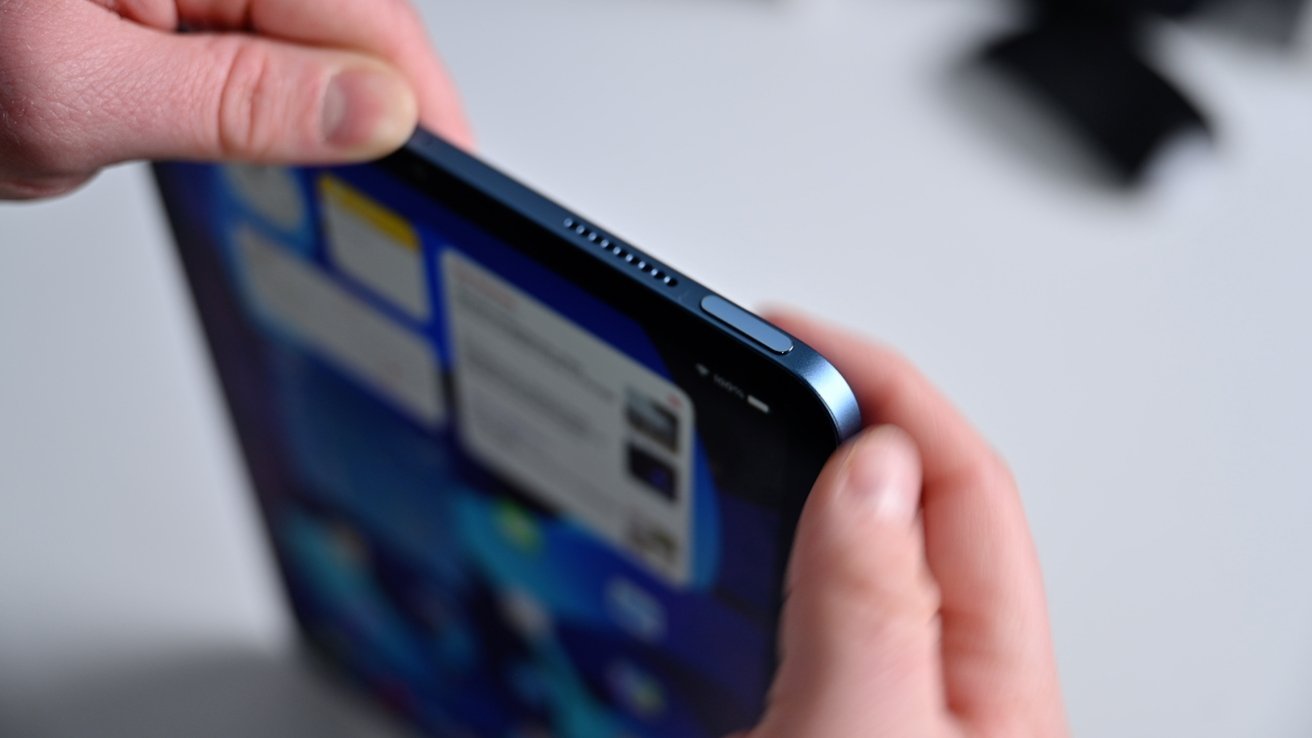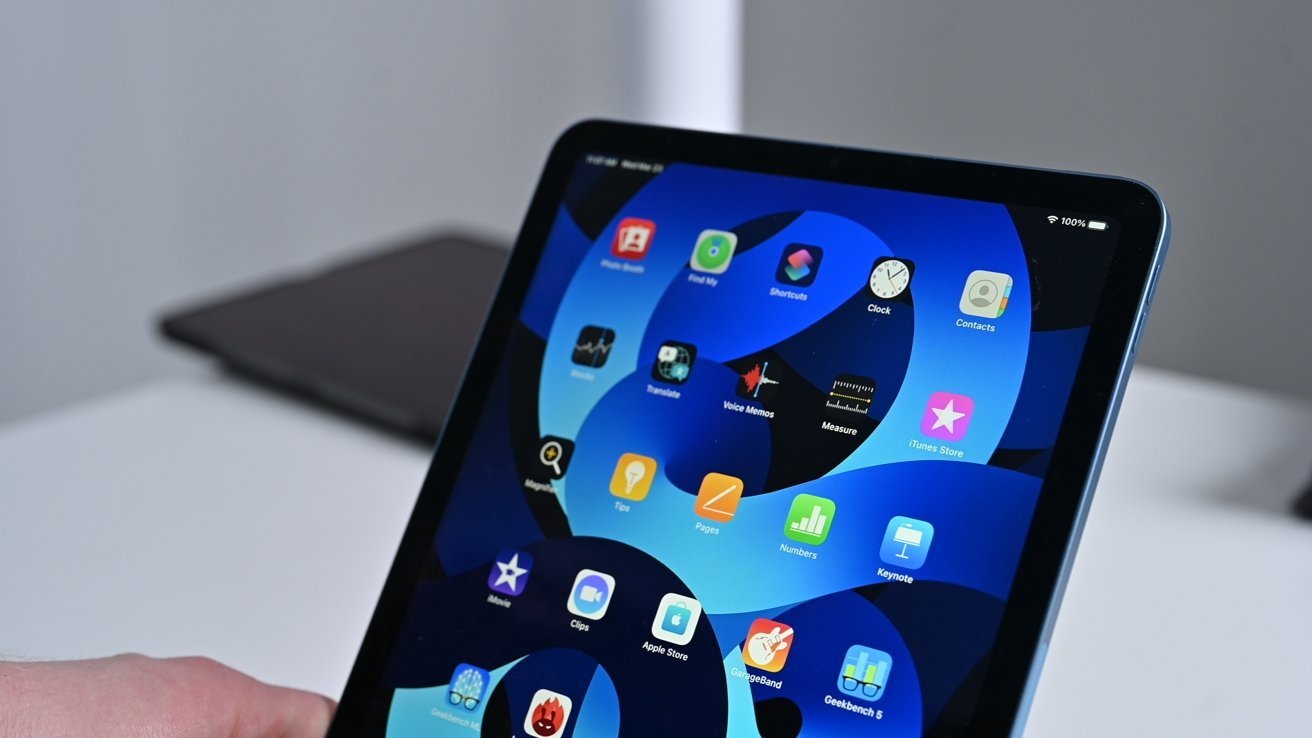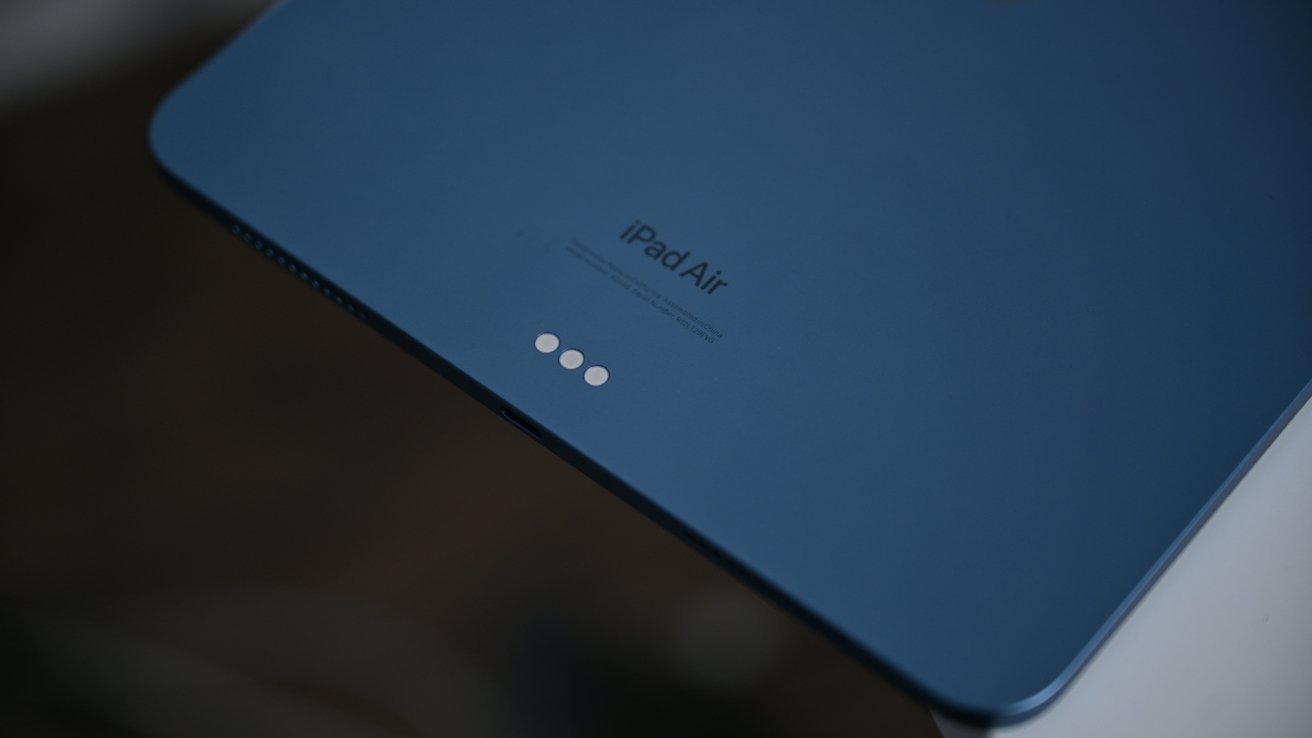2025 iPad 11 vs M1 iPad Air: Newer isn't always better
Apple's 2025 iPad 11 is Apple's new budget tablet. The biggest problem for it is that the 2022 iPad Air is almost always a better product for about the same money. Here's how the two compare.

iPad 11 [left], iPad Air M1 [right]
In our review of the 2025 iPad 11, we concluded that most users in the market for a new iPad are better served with the M1 iPad Air, versus the 2025 iPad 11. It turns out when you publish a review of a new product, and say that a product from a few years ago is a better deal overall, there's a demand for more detailed information than a passing remark or two.
And, in that review, Managing Editor Mike Wuerthele noted that the 2025 iPad brings the value end of Apple's tablet spectrum in line with the rest, as far as design goes.
As a model replaced by M2 and M3-based variants, the first Apple Silicon iPad Air, using the M1 chip is clearly not new. Apple only has it in the refurb shop.
Even so, there's a compelling argument for getting the older M1 iPad Air instead of the latest 2025 iPad 11. Here is the breakdown between the old iPad Air and the new iPad 11.
2025 iPad 11 vs M1 iPad Air - Specifications
| Specifications | M1 iPad Air | 2025 iPad 11 |
|---|---|---|
| Price (starting at launch) | $599 Available at Amazon | $349 Check sale prices |
| Dimensions (inches) | 9.74 x 7.02 x 0.24 | 9.79 x 7.07 x 0.28 |
| Screen size (inches) | 10.9 | 11 |
| Weight (pounds) | 1.02 (Wi-Fi), 1.02 (Cellular) | 1.05 (Wi-Fi), 1.06 (Cellular) |
| Processor | M1 | A16 |
| Storage | 64GB, 256GB | 128GB, 256GB, 512GB |
| Display type | Liquid Retina, True Tone, Wide color (P3), | Liquid Retina, True Tone, sRGB color |
| Resolution | 2,360 x 1,640 at 264ppi | 2,360 x 1,640 at 264ppi |
| Brightness (nits) | 500 | 500 |
| Apple Pencil | Apple Pencil Second Generation, Apple Pencil USB-C | Apple Pencil First Generation, Apple Pencil USB-C |
| Connectivity | Wi-Fi 6, Bluetooth 5.0 5G sub-6GHz (cellular) Smart Connector, USB-C | Wi-Fi 6, Bluetooth 5.3 5G sub-6GHz (cellular) Smart Connector, USB-C |
| Rear camera (MP) | 12MP Wide | 12MP Wide |
| Front camera (MP) | 12MP Ultra Wide | Landscape 12MP Center Stage |
| Video recording | 4K at 24/30/60fps | 4K at 24/30/60fps |
| Biometric | Touch ID | Touch ID |
| Speakers | Landscape Stereo | Landscape Stereo |
| Battery Size (Video playback time) | 10 hours | 10 hours |
2025 iPad 11 vs M1 iPad Air - Physical Appearance
It's fair to say that there is a distinct level of similarity between the two models being compared here. Externally, they look the same, complete with the edge-to-edge display, the construction of the back, and button layouts.
Both rely on aluminum for the enclosure, which is modern and flat-sided, using Apple's current design language. The back looks quite similar too, with the use of one solitary camera and no expanded bump section.
Both also have Touch ID embedded in the top button, handling biometric security duties.
If you look carefully, there are some differences, but they are small.

2025 iPad 11 vs M1 iPad Air: Touch ID is located in the top button on both models.
Externally, the easiest to spot is the front-facing camera. While it is on a short side on the iPad Air, meant for portrait orientation usage in calls, the iPad instead has it on a long edge, making it more useful when used in calls in a landscape orientation.
When it comes to physical dimensions, the new iPad is ever so marginally bigger than the M1 iPad Air. The three-year-old model has a footprint of 9.74 inches by 7.02 inches, while the iPad 11 is a smidgeon larger at 9.79 inches by 7.02 inches.
You're not really going to notice this, unless you actively measure the two models.
Thickness, however, is more easily spotted, with the M1 iPad Air at 0.24 inches versus 0.28 inches for the iPad 11. The iPad Air is near enough 15% thinner than the newer model.
There's also a tiny bit more heft in the new model. While the M1 iPad Air is 1.02 pounds in both its Wi-Fi and Cellular forms, the iPad 11 is 1.05 pounds for the Wi-Fi model, 1.06 pounds for Cellular.
Again, these size and weight differences are unlikely to be considered as major enough to matter to consumers, since they are extremely minor.
2025 iPad 11 vs M1 iPad Air - Displays
When it comes to the screens, the extreme similarity between the models continues to be a thing.
Both models have what is referred to as a Liquid Retina display, referring to Apple's LED backlighting system and rounded corners of the screen. There's no difference in brightness, as each can manage up to 500 nits of brightness for SDR content.
The resolutions are also identical, with both at 2,360 by 1,640 pixels and a pixel density of 264 pixels per inch apiece.

2025 iPad 11 vs M1 iPad Air: Apple says the screens are 11 inches and 10.9 inches respectively.
What could be considered a big difference is the quoted size of each, with the iPad Air said by Apple to have a 10.9-inch display, while the iPad 11 has an 11-inch screen. The problem is, it's not 11 inches.
Apple's technical specs for the iPad 11 discloses that it has rounded corners, and that when measured diagonally as usual, the screen size is really 10.86 inches.
In effect, Apple is rounding up what it calls the screen size.
There are still technological differences, with the iPad 11 having sRGB color coverage while the iPad Air boasts P3 wide color. Both do have True Tone support and a fingerprint-resistant oleophobic coating, but the iPad Air's also got an antireflective coating and is fully laminated.
As for Apple Pencil support, the iPad 11 can handle the USB-C Apple Pencil as well as the first-gen Apple Pencil, when used with the USB-C to Apple Pencil adapter. The iPad Air also uses the USB-C Apple Pencil, as well as the second-gen Apple Pencil with its double-tap feature.
The iPad Air has a bit of an advantage with its screen, but it's a slim one.
2025 iPad 11 vs M1 iPad Air - Performance
A big difference to take into account is the processing of each tablet. They are different generations and different classes of tablet, and that impacts the chips that are in use.
The iPad 11 uses the A16 chip, which is best known for being used in the iPhone 14 Pro and the iPhone 15. It's a chip that is two and a half years old.
The version of the A16 in use in the 2025 iPad 11 is one with a five-core CPU, with two performance cores and three efficiency cores, as well as a 16-core Neural Engine and a four-core CPU.
Over on the iPad Air, the model being looked at has the M1, which has an eight-core CPU with four performance cores and four efficiency cores, an eight-core GPU, and a 16-core Neural Engine.
As a desktop-class chip with lots more cores, this should mean the M1iPad Air will do a lot better than the iPad 11's A16.

2025 iPad 11 vs M1 iPad Air: Geekbench Single-core Benchmarks
The Geekbench single-core benchmark for the iPad Air with M1 puts it at a score of 2,288. However, the same test for the iPad 11 brings up a result of 2,412, a marginally better result.
However, the multi-core test lands squarely in the M1's favor, scoring 8,248 to 6,202. The obvious reason for this is core counts, as the M1 simply has more at its disposal.

2025 iPad 11 vs M1 iPad Air: Geekbench Multi-core Benchmarks
Likewise, the Metal score on the iPhone 14 Pro is 22,721, while the M1 gets 32,193. Once again, we're talking differences in core counts here.

2025 iPad 11 vs M1 iPad Air: Geekbench Metal Benchmarks
This difference could've been reduced a bit had Apple used the A16 from the iPhone 14 Pro, which has a six-core CPU and five-core GPU. Alas, it did not.
It's safe to say that there is relatively little difference between the tablets in simple single-core tasks. But, if you open the taps with a multi-core or graphically intensive task, the M1 will do things much better.
It's also worth mentioning that the iPad 11 will not be able to take advantage of Apple Intelligence, simply because the A16 is just below the minimum specification for the features. The older iPad Air, complete with the M1 chip, does support Apple Intelligence, like all other Apple Silicon devices.
If you want to get on the Apple Intelligence bandwagon, the iPad 11 is not the way to go.
2025 iPad 11 vs M1 iPad Air - Cameras and Audio
After a diversion of difference in performance, we come back to similarity again by looking at the cameras. Both use the same 12MP Wide camera with an f/1.8 aperture and 5x digital zoom.
Video capabilities for the cameras are identical, too, with 4K 60fps video, 30fps with extended dynamic range, a 3x video zoom, and Slo-Mo at 1080p 240fps.
The story's the same around the front, with a 12MP Ultra Wide camera used in each, complete with an f/2.4 aperture, 2x zoom out, Retina Flash, and Center Stage support.

2025 iPad 11 vs M1 iPad Air: Stereo speakers and USB-C are in use in both models.
The only differences for the cameras is the use of Smart HDR 4 for Photos in the iPad 11 versus Smart HDR 3 for Photos in the iPad Air, and the position of the front camera to be better used for landscape-orientation video calls.
Audio is provided by landscape stereo speakers on both models, while a pair of microphones handle audio pickup duties.
2025 iPad 11 vs M1 iPad Air - Connectivity and Battery
For connectivity, both models take advantage of USB-C for physically charging and for data. The port is the same on both, located in identical places, with mirroring capabilities.
Both also have a Smart Connector on the rear, which can let you hook the respective tablets to keyboard accessories.
For wireless connectivity, there's Wi-Fi 6 on both models, but the newer iPad has Bluetooth 5.3 versus Bluetooth 5.0 in the iPad Air. This really isn't a major issue for the vast majority of uses and accessories.
There are two versions of each model, with Wi-Fi only and Wi-Fi + Cellular variants available for both. This is also fairly similar, with 5G support limited to sub-6GHz bands and not the faster mmWave connections.
The M1 iPad Air does benefit from having both a SIM card slot for a physical Nano-SIM and eSIM support. Apple's trend of supporting only eSIMs in new devices means you can't insert a physical SIM into the iPad 11 in the United States.
2025 iPad 11 vs M1 iPad Air - Capacity and Pricing
The iPad 11 is offered by Apple in a choice of three capacities: 128GB, 256GB, and 512GB. Pricing starts from $349 for the 128GB, rising to $449 for 256GB, and $649 for 512GB, with Cellular models costing an extra $150.
Color-wise, there are four options: Blue, Pink, Yellow, and Silver.

2025 iPad 11 vs M1 iPad Air: Smart Connectors hook the iPad and iPad Air up to keyboard accessories
The iPad Air with M1 was sold in a choice of two capacities: 64GB or 256GB. At launch, that meant you could get the base model without Wi-Fi for $599.
There were also five color options: Space Gray, Blue, Pink, Purple, and Starlight.
However, Apple discontinued the M1 iPad Air when it was replaced with the M2 model, and the $599 starter price doesn't apply. If you want one, you're going to go down the second-hand route.
Apple's Certified Refurbished store lists the fifth-gen iPad Air with M1 and Wi-Fi only at $379 for the 64GB model, $499 for the 256GB version.
With the second-hand market as it is, you could probably pick up a similar or better price for the M1 iPad Air from other retailers. But, the comparative pricing here shows they are fairly close.
2025 iPad 11 vs M1 iPad Air - Is newer better?
It's very easy to say that the iPad 11 of 2025 and the three-year-old M1 iPad Air are quite similar tablets. The vast majority of external or connectivity features are either identical or very close with marginal alterations.
The differences that come into play are mostly internal. Aside from the modernization of storage capacity levels and the slightly better display, where the M1 iPad Air excels is with the M1 itself.
Sure, for general browsing or low-performance tasks, the iPad 11 and iPad Air will be in the same ballpark. But if you push them, the M1 will beat the A16 any day, especially the neutered version used here.
With the relatively little difference in refurbished pricing of the M1 iPad Air versus the brand new iPad 11, there's arguably enough changes to warrant a second look at the older iPad Air as a potential purchase. If performance is key and you can look past buying a used model, it's hard not to recommend the M1 iPad Air as the better option.
The iPad 11 will still be the entry-level option for the majority of consumers. The M1 iPad Air is just better in nearly every regard.
2025 iPad 11 vs M1 iPad Air - Where to buy
Apple's iPad 11 is on sale now, with every model eligible for exclusive pricing at Apple Premier Partner Expercom when you shop through this activation link. Just look for the special AppleInsider price above the Add to Cart button on Expercom's product pages.
Amazon and B&H are also running sales on the 2025 models. You can compare prices across these retailers and more in our iPad 11 Price Guide -- and find the best iPad deals across Apple's entire lineup in our dedicated roundup.
Apple, meanwhile, has Certified Refurbished M1 iPad Airs available, with prices from $379. Best Buy is also running a clearance sale on M2 models in new condition, delivering up to $100 off at press time. And for the latest models, shop the best M3 iPad Air prices in our Price Comparison Guide.
Read on AppleInsider

Comments
As always, pick what works better for you.
If you game at all, yes. Different users prioritize different things. If your friends and family prioritize storage, there's a marginally better choice for them in the new iPad.
If you plan on using an iPad, or any computer, for a 5, 6, 8+ years, get more than you think you need. The extra $200 today is a small price to pay when your device is going to be used for 5+ years. That $200 will make the device a better device in 5+ years.
For me, I only care about weight and display with my iPad.
Given that I only use to surf the web and never watch videos, processing power is of zero interest.
I own an iPad Air 2022, but will look more closely and the entire line when I replace it is about 3 years.
Apple has long had product tiers and pricing tiers with a certain degree of price overlap due to individual product options, features, compatibility, and the number and type of older generation products that are still available for sale. In certain price ranges the MacBook Air and MacBook Pro have been hard to choose between unless there is one attribute on one platform that sways the decision. If a buyer is intensely focused on meeting their needs with a number of products to select from within a certain price range, they’d be wise to look at earlier and especially earlier higher tier products as an option. That’s true with a lot of consumer products, from iPhones to automobiles.
Trade-offs are inevitable no matter how you look across the pool of candidates. It’s not unique only across different release years, different tiers, but even within the same product line within a tier. Selection may also consider future potential, but there can be a lot of uncertainty there. Who would have imagined that the iPhone 14 Pro Max would be incompatible with a frontline feature on the iPhone 15? That is like getting a door slammed in your face, especially if you’re still paying for last year’s model. Emphasis on “last year’s,” not 3 generations ago. There’s not enough lipstick in the world to make that epic knock-down pig look appealing. At the highest level, choices may also include looking across product brands.
The most difficult part is figuring out what customers, or yourself, really need, now, tomorrow, and in Apple’s new evolution strategy, next year.
Knowledgeable advice, like what AppleInsider is trying to provide here is helpful, but here it’s really focused on the technology literate, not Mom, Dad or Grandpa. They’re not looking at benchmarks. They may not care about having an extra port, lidar, or integrated AI. This is why it would be hard for me to work at an Apple Store. I’m sure most Apple Store employees are trying to do what’s best for their customers, but they only have a tiny amount of understanding of what their customer’s needs truly are, both now and in the future. The customers may have no clue or only a very generic understanding, including nonfunctional s like the color choices. The “safe” route is probably to sell customers more than what they probably need right now to give the seller and their customers a certain level of assurance that their customers will not be disappointed at some point in the near future, you know, like next year.